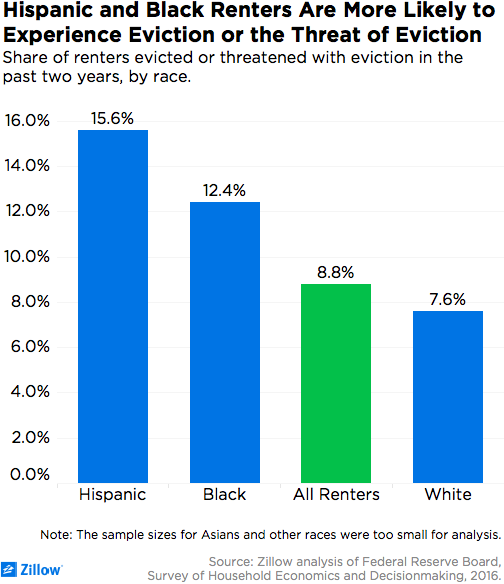Financial Hardship Is Widespread, Especially for Households Earning Less Than $40,000
Nearly a third (30.0 percent) of households nationwide – meaning about 73 million adults— report they are struggling or just getting by financially, according to data from the Federal Reserve Board’s recently released 2016 Survey of Household Economics and Decisionmaking (SHED). More than half (51.3 percent) say they do not have enough funds saved to cover three months of living expenses.
- Nearly a third (30.0 percent) of households nationwide – meaning about 73 million adults— report they are struggling or just getting by financially.
- More than half (52.5 percent) of households earning less than $40,000 a year say they’re either struggling or just getting by.
- Blacks and Hispanics are far more likely to experience eviction or the threat of eviction.
Homelessness can seem like a distant problem to people who are doing well financially, but economic hardship is not rare: Nearly a third (30.0 percent) of households nationwide – meaning about 73 million adults— report they are struggling or just getting by financially, according to data from the Federal Reserve Board’s recently released 2016 Survey of Household Economics and Decisionmaking (SHED). More than half (51.3 percent) say they do not have enough funds saved to cover three months of living expenses.
The situation is even more dire for people with low incomes. More than half (52.5 percent) of households earning less than $40,000 a year say they’re either struggling or just getting by. For perspective, the typical renter makes less than that – $38,128 a year, according to the U.S. Census Bureau’s 2016 Current Population Survey (CPS).
It’s no wonder that two-thirds of renters say a down payment is a major hurdle to buying a home. More than half of renters (51.4 percent) make less than $40,000 a year and therefore fall into an income category for which the top financial worries are being able to afford the rent, food, gasoline, utilities and other bills, according to SHED. By contrast, households earning between $40,000 and $100,000 a year say they worry about money in general, the cost of maintaining their health and insurance, retiring and how much money they make. For people who earn more than $100,000, common financial concerns include paying for college and retirement.
The hardships for renters appear in how little they have saved. A large share of them – 68.8 percent – do not have enough funds to cover three months of living expenses. That compares with 39.7 percent of homeowners. Rent plays a major role: 60 percent of rent-burdened households — those paying in excess of 36 percent of their incomes on rent — report saving nothing at all, according to earlier research.
Renters’ hardships also are compounded by evictions. Nine percent of renters nationally say they’ve either been evicted or received a threat of eviction in the past two years. That compares with 4.9 percent of homeowners who said they’ve either been foreclosed on or been concerned about a future foreclosure during the past two years.
For renters making less than $40,000 a year, the share evicted or threatened with eviction jumps to 13 percent.
Blacks and Hispanics are far more likely to experience eviction or the threat of eviction. While just 7.6 percent of whites report having that experience in the past two years, 12.4 percent of blacks and 15.6 percent of Hispanic renters say they have.
Related:

